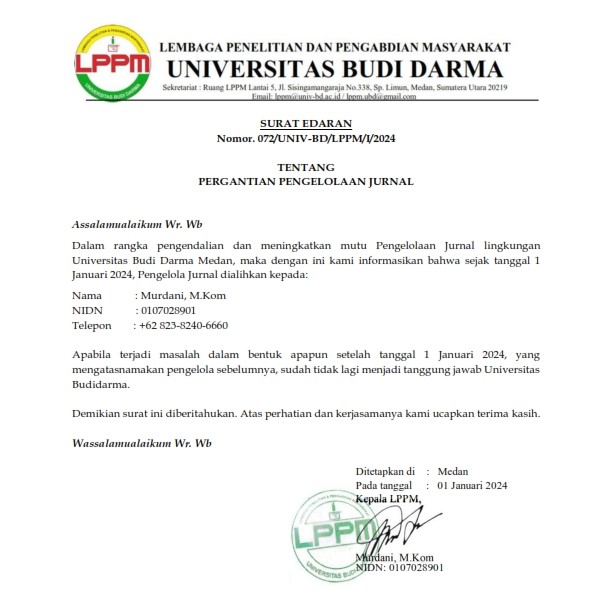Data Mining Dalam Analisis Faktor Drop Out Mahasiswa Menerapkan Algoritma Decision Tree
DOI:
https://doi.org/10.30865/mib.v8i2.7379Keywords:
CART, Decision Tree, Dropout, LightgbmAbstract
Graduation accuracy is one of the indicators used in assessing the suitability of undergraduate programs as a functional unit of higher education. Knowing the factors that influence student graduation time helps study programs and faculties make decisions to increase the number of students who graduate on time. The purpose of this research is to obtain an overview of the factors that influence students in the accuracy of completing the study time by using the Machine Learning algorithm, namely Decision Tree, which is expected to have high classification efficiency and good description so that it can increase the number of students graduating on time. The methods used to determine student dropout factors are Classification and Regression Tree (CART) and LightGBM. The data used is the data of undergraduate students of Universitas Muhammadiyah Sumatera Utara in 2019. The quality of classification can be read from the accuracy, sensitivity and specification values. The result using CART is 95.1% with the most influencing factors are GPA, faculty, lecture time and predicate while Lightgbm is 83% with the most influencing factors are GPA, gender, lecture time and faculty. Decision tree can be used to determine student dropout factors because of its high accuracy with GPA being the main factor.
References
H. Abijono, P. Santoso, and N. L. Anggreini, “Algoritma Supervised Learning Dan Unsupervised Learning Dalam Pengolahan Data,†J. Teknol. Terap. G-Tech, vol. 4, no. 2, pp. 315–318, 2021, doi: 10.33379/gtech.v4i2.635.
M. Azhari, S. Efendi, P. Purwanto, and H. Maulana, “Applying the simplex method to optimize employee distribution to increase sales internet data package,†Indones. J. Educ. Math. Sci., vol. 4, no. 3, pp. 143–148, 2023, doi: https://doi.org/10.30596/ijems.v4i3.15151.
S. Wiyono, D. S. Wibowo, M. F. Hidayatullah, and D. Dairoh, “Comparative Study of KNN, SVM and Decision Tree Algorithm for Student’s Performance Prediction,†Int. J. Comput. Sci. Appl. Math., vol. 6, no. 2, p. 50, 2020, doi: 10.12962/j24775401.v6i2.4360.
R. M. Aguilar-Chinea, I. C. Rodriguez, C. Expósito, B. Melian-Batista, and J. M. Moreno-Vega, “Using a decision tree algorithm to predict the robustness of a transshipment schedule,†Procedia Comput. Sci., vol. 149, pp. 529–536, 2019, doi: 10.1016/j.procs.2019.01.172.
R. Latifah, E. S. Wulandari, and P. E. Kreshna, “Model Decision Tree untuk Prediksi Jadwal Kerja menggunakan Scikit-Learn,†Semin. Nas. Sains dan Teknol., vol. 16, pp. 1–6, 2019.
D. Zhang et al., “An Interpretable Station Delay Prediction Model Based on Graph Community Neural Network and Time-Series Fuzzy Decision Tree,†IEEE Trans. Fuzzy Syst., vol. 31, no. 2, pp. 421–433, 2023, doi: 10.1109/TFUZZ.2022.3181453.
F. Manzella, G. Pagliarini, G. Sciavicco, and I. E. Stan, “The voice of COVID-19: Breath and cough recording classification with temporal decision trees and random forests,†Artif. Intell. Med., vol. 137, no. December 2022, p. 102486, 2023, doi: 10.1016/j.artmed.2022.102486.
J. Y. Nakayama, J. Ho, E. Cartwright, R. Simpson, and V. S. Hertzberg, “Predictors of progression through the cascade of care to a cure for hepatitis C patients using decision trees and random forests,†Comput. Biol. Med., vol. 134, no. April, p. 104461, 2021, doi: 10.1016/j.compbiomed.2021.104461.
H. Toyoda, H., Terai, H., Yamada, K., Kato, M., Suzuki, A., Takahashi, S., ... & Nakamura, “decision tree analysis to predict clinical outcome of minimally invasive lumbar decompression surgery for lumbar spinal stenosis with and without coexisting spondylolisthesis and scoliosis.,†Spine J., pp. 23(7), 973-981., 2023.
I. W. Misshuari, R. Herdiana, F. Farikhin, T. Afrizal, and J. Saputra, “Factors that affect customer credit payments during Covid 19 pandemic: An application of Light Gradient Boosting Machine (LightGBM) and Classification and Regression Tree (CART),†Ind. Eng. Oper. Manag. Singapore, pp. 5083–5091, 2021.
B. Charbuty and A. Abdulazeez, “Classification Based on Decision Tree Algorithm for Machine Learning,†J. Appl. Sci. Technol. Trends, vol. 2, no. 01, pp. 20–28, 2021, doi: 10.38094/jastt20165.
R. Ahmad, S. A. Po, and R. . Ageng, “Pemanfaatan machine learning dalam berbagai bidang: Review paper,†Indones. J. Comput. Inf. Technol., vol. 5, no. 1, pp. 75–82, 2020, doi: 10.31294/ijcit.v5i1.7951.
F. Dwi Meliani Achmad, Budanis, Slamat, “Klasifikasi Data Karyawan Untuk Menentukan Jadwal Kerja Menggunakan Metode Decision Tree,†J. IPTEK, vol. 16, no. 1, pp. 18–23, 2019, [Online]. Available: http://jurnal.itats.ac.id/wp-content/uploads/2013/06/3.-BUDANIS-FINAL-hal-17-23.pdf
Downloads
Published
Issue
Section
License

This work is licensed under a Creative Commons Attribution 4.0 International License
Authors who publish with this journal agree to the following terms:
- Authors retain copyright and grant the journal right of first publication with the work simultaneously licensed under Creative Commons Attribution 4.0 International License that allows others to share the work with an acknowledgment of the work's authorship and initial publication in this journal.
- Authors are able to enter into separate, additional contractual arrangements for the non-exclusive distribution of the journal's published version of the work (e.g., post it to an institutional repository or publish it in a book), with an acknowledgment of its initial publication in this journal.
- Authors are permitted and encouraged to post their work online (e.g., in institutional repositories or on their website) prior to and during the submission process, as it can lead to productive exchanges, as well as earlier and greater citation of published work (Refer to The Effect of Open Access).



